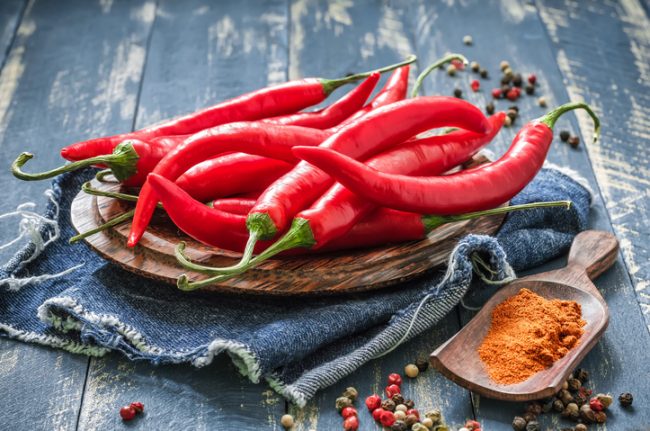The vast majority of us are on an eternal search for health hacks—things we can change and habits we can adopt to improve our mood, enhance our energy, combat stress, and—fingers crossed—increase our lifespan.
But did you know that one of the biggest current health trends is literally hot?
Spicy foods have been dominating conversations for the last few years, when, in 2014, a new study set forth in The BMJ (formerly known as the British Medical Journal) asserted that certain spices may lead to longevity.
“We know something about the beneficial effects of spicy foods basically from animal studies and very small-sized human studies,” said Lu Qi, one of the study’s authors and an associate professor at the Harvard School of Public Health. “Some of those studies have found that spicy food and their active components—like capsaicin, the compound found in chili peppers—might lower inflammation, improve metabolic status and have a positive effect on gut bacteria and weight,” Time went on to report.†
Sound sizzling-delicious (in more ways than one)? Here are three best spices to weave into your diet—and why they’re a boon for your brain and body.
1. Chili peppers/cayenne
From sliced jalapenos to cayenne chicken, chili peppers are versatile jewels that do a whole lot more than just titillate the tongue.
One of chili’s (including cayenne’s) chief components is the very element mentioned above: capsaicin. Capsaicin is “a thermogenic substance,” Fox News reports, in that it engenders an increase in body temperature, temporarily bolstering metabolism and “revving its ability to burn calories.” What’s more, the active component of chili peppers has been demonstrated to decrease appetite and help curtail cravings. Translation? Eating more chili peppers may convert into weight loss.†
In addition, capsaicin is acclaimed for its potential facility to diminish pain. Indeed, the compound is a primary ingredient in many over-the-counter pain medications, Reader’s Digest reports. “Over time,” the magazine writes, “it short-circuits pain by depleting nerve cells of a chemical called substance P, which helps transfer pain signals along nerve endings to the brain.” And if you happen to have a runny nose or other cold symptoms, you might want to spice it up at your next meal: Capsaicin may offer decongestant benefits.†
Found in tabasco (and other hot sauces), sliding in some cayenne (and/or actual chili peppers) is a simple and scrumptious task. Either fresh or dried, cayenne can be tossed into salads, dips, and soups for an extra kick, sprinkled on top of flatbread for a tantalizing jolt, or stirred into any recipe starring chocolate. Chipotle hot cocoa, anyone?
2. Turmeric
Happen to be an avid fan of Indian food? You’re doing more for your health than simply satisfying a craving by digging into a bowl of curry: One of the main active components of curry is turmeric, a perennial plant that hails from the ginger family and contains what’s known as curcumin.
Historically used in Ayurvedic and traditional Chinese medicine, curcumin is believed to be one of the most valuable and effective phytochemicals available. To date, more than six thousand peer-reviewed articles have been conducted on this turmeric, with studies demonstrating that it may aid with everything from mood to joint health.†
Biryani not necessarily your thing? Not a problem: Given the versatility of this Southeast-Asian spice, it can be added to a variety of dishes, such as soups, salads, stir fries, rice and quinoa, roasted vegetables, homemade mustards and hummus, even scrambled eggs and quiches. Another option? Sip it. Turmeric tea offers both comfort and zing, particularly if you include a dash of black pepper—which may bolster absorption.†
3. Cinnamon
Fragrant, piquant, and just plain lovely, cinnamon may not be as fiery as its sisters, cayenne and turmeric, but it nevertheless adds some serious bite to beverages and dishes.
Moreover, it’s one of the healthiest spices in existence. Derived from the cinnamon vernun tree, it’s cherished for the antioxidant properties found in its primary active ingredient, cinnameldahyde, and has been shown to naturally support immune, heart and digestive health, cholesterol levels and brain function. Additionally, cinnamon may help to support healthy blood sugar levels. As for those seasonal allergies that creep up? Consider a stalk of this peppery spice: Cinnamon may help to ease allergy symptoms.†
Simultaneously sweet and spicy, it’s easy to incorporate more cinnamon into your diet. Whether you go with Ceylon cinnamon or Cassia (the former is considered “purer” while the latter is most common in the U.S.), get creative: Sprinkle some into your yogurt or oatmeal, add a pinch to your coffee, tea, or smoothie, serve it on top of a plate of roasted butternut squash, or spoon it over a baked apple.
And if none of these spices sound palatable? Not to worry—all three can be found in dietary supplements.
†These statements have not been approved by the Food and Drug Administration. These products are not intended to diagnose, treat, cure or prevent disease.

